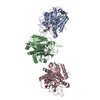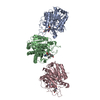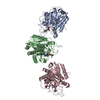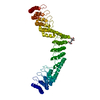[English] 日本語
 Yorodumi
Yorodumi- SASDB64: Leishmania braziliensis stress-induced protein sti1 (LbHop TPR2A-... -
+ Open data
Open data
- Basic information
Basic information
| Entry | Database: SASBDB / ID: SASDB64 |
|---|---|
 Sample Sample | Leishmania braziliensis stress-induced protein sti1 (LbHop TPR2A-TPR2B-DP2 construct)
|
| Function / homology |  Function and homology information Function and homology information |
| Biological species |  Leishmania braziliensis (eukaryote) Leishmania braziliensis (eukaryote) |
 Citation Citation |  Journal: Arch Biochem Biophys / Year: 2016 Journal: Arch Biochem Biophys / Year: 2016Title: Low sequence identity but high structural and functional conservation: The case of Hsp70/Hsp90 organizing protein (Hop/Sti1) of Leishmania braziliensis. Authors: Fernanda A H Batista / Thiago V Seraphim / Clelton A Santos / Marisvanda R Gonzaga / Leandro R S Barbosa / Carlos H I Ramos / Júlio C Borges /  Abstract: Parasites belonging to the genus Leishmania are subjected to extensive environmental changes during their life cycle; molecular chaperones/co-chaperones act as protagonists in this scenario to ...Parasites belonging to the genus Leishmania are subjected to extensive environmental changes during their life cycle; molecular chaperones/co-chaperones act as protagonists in this scenario to maintain cellular homeostasis. Hop/Sti1 is a co-chaperone that connects the Hsp90 and Hsp70 systems, modulating their ATPase activities and affecting the fate of client proteins because it facilitates their transfer from the Hsp70 to the Hsp90 chaperone. Hop/Sti1 is one of the most prevalent co-chaperones, highlighting its importance despite the relatively low sequence identity among orthologue proteins. This multi-domain protein comprises three tetratricopeptides domains (TPR1, TPR2A and TPR2B) and two Asp/Pro-rich domains. Given the importance of Hop/Sti1 for the chaperone system and for Leishmania protozoa viability, the Leishmania braziliensis Hop (LbHop) and a truncated mutant (LbHop(TPR2AB)) were characterized. Structurally, both proteins are α-helix-rich and highly elongated monomeric proteins. Functionally, they inhibited the ATPase activity of Leishmania braziliensis Hsp90 (LbHsp90) to a similar extent, and the thermodynamic parameters of their interactions with LbHsp90 were similar, indicating that TPR2A-TPR2B forms the functional center for the LbHop interaction with LbHsp90. These results highlight the structural and functional similarity of Hop/Sti1 proteins, despite their low sequence conservation compared to the Hsp70 and Hsp90 systems, which are phylogenetic highly conserved. |
 Contact author Contact author |
|
- Structure visualization
Structure visualization
| Structure viewer | Molecule:  Molmil Molmil Jmol/JSmol Jmol/JSmol |
|---|
- Downloads & links
Downloads & links
-Data source
| SASBDB page |  SASDB64 SASDB64 |
|---|
-Related structure data
| Related structure data | C: citing same article ( |
|---|---|
| Similar structure data |
- External links
External links
| Related items in Molecule of the Month |
|---|
-Models
| Model #483 |  Type: dummy / Software: DAMFILT / Radius of dummy atoms: 1.90 A / Chi-square value: 1.749 / P-value: 0.203609  Search similar-shape structures of this assembly by Omokage search (details) Search similar-shape structures of this assembly by Omokage search (details) |
|---|
- Sample
Sample
 Sample Sample | Name: Leishmania braziliensis stress-induced protein sti1 (LbHop TPR2A-TPR2B-DP2 construct) Specimen concentration: 1.40-8.50 |
|---|---|
| Buffer | Name: Tris / Concentration: 25.00 mM / pH: 7.5 Composition: 100 mM NaCl, 1 mM EDTA, 1 mM β-mercaptoethanol |
| Entity #315 | Name: Truncated Hop/Sti1 / Type: protein Description: Stress-induced protein sti1 (Hop TPR2A-TPR2B-DP2 construct) Formula weight: 43.7 / Num. of mol.: 1 / Source: Leishmania braziliensis / References: UniProt: A4H5F0 Sequence: GSHMEDQRFA LTLMYLSGMK IPNDDEDDEE ERPSAKAAAE AKAKEEKKLL TDNEKEAMAL KEEGNKLYLS KRFEEALSKY QEAQAKDPKN TLYILNVSAV YFEQRDYEKC ITECERGIEH GRENHCDYTI VAKLMTRHAF CLQKQKKYEA AIDLYKRALV EWRNPDTLKK ...Sequence: GSHMEDQRFA LTLMYLSGMK IPNDDEDDEE ERPSAKAAAE AKAKEEKKLL TDNEKEAMAL KEEGNKLYLS KRFEEALSKY QEAQAKDPKN TLYILNVSAV YFEQRDYEKC ITECERGIEH GRENHCDYTI VAKLMTRHAF CLQKQKKYEA AIDLYKRALV EWRNPDTLKK LTECEKEHQK AVEEAYIDPE IARQKKDEGN QYFKEDKFPE AVAAYTEAIK RNPAEHTSYS NRAAAYIKLG AFNDALKDAE KCIELKPDFV KGYARKGHAY FWTKQYNRAL QAYDEGLKVD PSNADCKDGR LRTIMRIQEM ASGQSADGDE AARRAMDDPE IAAIMQDSYM QLVLKEMQND PTRIQEYMKD PGISVKINKL ISAGIIRFGQ |
-Experimental information
| Beam | Instrument name: Brazilian Synchrotron Light Laboratory SAXS2 Beamline City: Campinas / 国: Brazil  / Type of source: X-ray synchrotron / Type of source: X-ray synchrotron | |||||||||||||||||||||||||||||||||
|---|---|---|---|---|---|---|---|---|---|---|---|---|---|---|---|---|---|---|---|---|---|---|---|---|---|---|---|---|---|---|---|---|---|---|
| Detector | Name: MAR 165 CCD | |||||||||||||||||||||||||||||||||
| Scan |
| |||||||||||||||||||||||||||||||||
| Distance distribution function P(R) |
| |||||||||||||||||||||||||||||||||
| Result |
|
 Movie
Movie Controller
Controller













